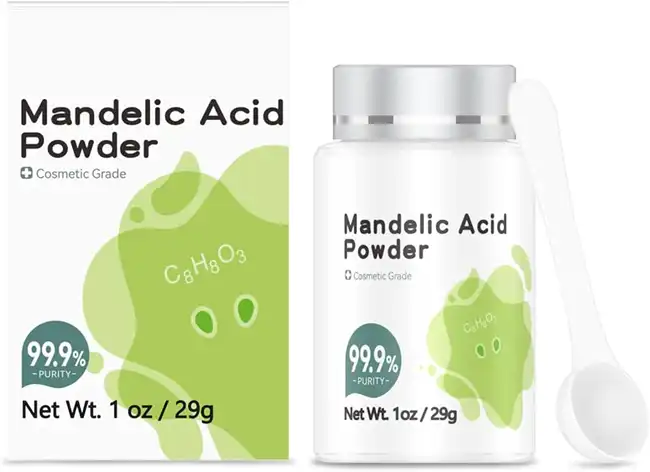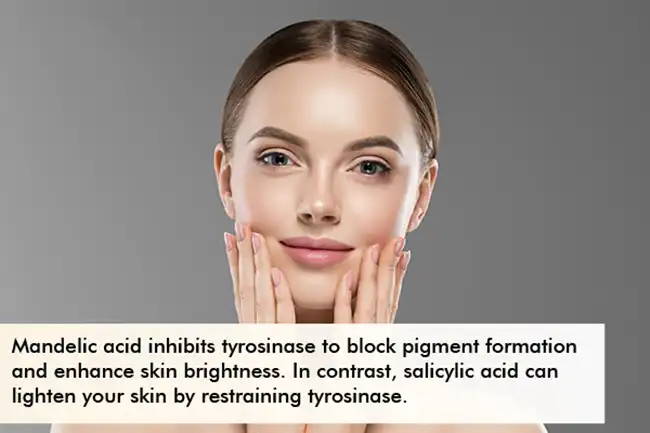D-Mandelic Acid vs L-Mandelic Acid: Key Differences
2025-01-09 16:45:28
When it comes to skincare ingredients, mandelic acid has gained significant attention for its gentle yet effective properties. However, not all mandelic acid is created equal. The two primary forms, D-Mandelic Acid and L-Mandelic Acid, have distinct characteristics that can impact their effectiveness and suitability for different skin types. D-Mandelic Acid is known for its superior antibacterial properties and faster penetration into the skin, making it particularly effective for acne-prone skin. On the other hand, L-Mandelic Acid is often praised for its gentler nature and suitability for sensitive skin types. Understanding these key differences is crucial for choosing the right mandelic acid variant for your skincare routine and achieving optimal results.
What is unique about D-Mandelic Acid?
Chemical Structure and Composition
D-Mandelic Acid, also known as (R)-Mandelic Acid, is a specific isomer of mandelic acid. Its molecular structure features a hydroxyl group and a carboxyl group attached to a central carbon atom, along with a phenyl group. This unique configuration gives D-Mandelic Acid its distinctive properties, setting it apart from its L-isomer counterpart.
Skin Penetration and Absorption
One of the standout features of D-Mandelic Acid is its enhanced ability to penetrate the skin. Due to its molecular structure, it can more easily pass through the skin's lipid barrier, allowing for deeper and more efficient absorption. This characteristic makes D-Mandelic Acid particularly effective in treating various skin concerns, as it can reach deeper layers of the epidermis where many skin issues originate.
Antibacterial and Exfoliating Properties
D-Mandelic Acid exhibits potent antibacterial properties, making it an excellent choice for those struggling with acne and other bacterial skin conditions. Its ability to combat harmful bacteria helps prevent breakouts and promotes clearer skin. Additionally, D-Mandelic Acid acts as an effective exfoliant, gently removing dead skin cells and promoting cell turnover. This dual action of fighting bacteria and exfoliating contributes to its effectiveness in improving overall skin texture and clarity.

Comparing D-Mandelic Acid and L-Mandelic Acid
Molecular Differences and Stereochemistry
The primary distinction between D-Mandelic Acid and L-Mandelic Acid lies in their stereochemistry. While they share the same chemical formula, their spatial arrangement of atoms differs. D-Mandelic Acid is the right-handed isomer, while L-Mandelic Acid is the left-handed isomer. This subtle difference in molecular structure leads to variations in their interactions with skin cells and overall effectiveness in skincare applications.
Efficacy in Treating Skin Concerns
Both D-Mandelic Acid and L-Mandelic Acid have shown efficacy in addressing various skin concerns, but their strengths differ. D-Mandelic Acid is often preferred for its superior antibacterial properties, making it particularly effective in treating acne and oily skin. It also demonstrates enhanced exfoliating capabilities, which can lead to more noticeable improvements in skin texture and tone. L-Mandelic Acid, while still effective, is generally considered gentler and may be more suitable for sensitive skin types or those new to using alpha-hydroxy acids in their skincare routine.
Skin Sensitivity and Tolerance
When it comes to skin sensitivity, L-Mandelic Acid is often touted as the more gentle option. Its larger molecular size means it penetrates the skin more slowly, which can result in less irritation for sensitive skin types. D-Mandelic Acid, while still considered gentle compared to other alpha-hydroxy acids, may cause slightly more sensitivity due to its deeper penetration and stronger exfoliating effects. However, individual skin reactions can vary, and what works best often depends on specific skin types and concerns.
Which Mandelic Acid Is Best for Your Skin?
Assessing Your Skin Type and Concerns
Choosing between D-Mandelic Acid and L-Mandelic Acid largely depends on your specific skin type and the concerns you're looking to address. If you have oily, acne-prone skin or are dealing with stubborn hyperpigmentation, D-Mandelic Acid might be the more effective choice due to its stronger antibacterial and exfoliating properties. For those with sensitive or reactive skin, or individuals new to using acid exfoliants, L-Mandelic Acid could be a gentler introduction to the benefits of mandelic acid.
Incorporating Mandelic Acid into Your Skincare Routine
Regardless of which form you choose, introducing mandelic acid into your skincare routine should be done gradually. Start by using it once or twice a week and slowly increase frequency as your skin adjusts. It's crucial to pair mandelic acid with a good sunscreen, as it can increase skin sensitivity to UV rays. For optimal results, consider using mandelic acid in the evening as part of your nighttime skincare routine, allowing it to work its magic while you sleep.
Potential Side Effects and Precautions
While mandelic acid is generally well-tolerated, some users may experience mild side effects such as redness, dryness, or slight peeling, especially when first starting use. These effects are typically temporary and subside as the skin adapts. However, if you experience persistent irritation or discomfort, it's advisable to reduce usage or consult with a dermatologist. It's also important to avoid using mandelic acid in combination with other strong exfoliants or retinoids, as this can lead to over-exfoliation and skin barrier damage.

Conclusion
Both D-Mandelic Acid and L-Mandelic Acid offer significant benefits for skin health, but their unique properties make them suitable for different skin types and concerns. D-Mandelic Acid shines in its antibacterial and exfoliating prowess, making it ideal for oily, acne-prone skin, while L-Mandelic Acid's gentler nature makes it a great option for sensitive skin or those new to acid exfoliation. Understanding these differences allows you to make an informed choice that best suits your skin's needs, paving the way for a more effective and personalized skincare routine.
Contact Us
To learn more about D-Mandelic Acid and how it can benefit your skin, or to explore our range of high-quality skincare ingredients, please contact us at Jessica@xazbbio.com. Our team of experts is ready to help you find the perfect solution for your skincare needs.
References
1. Smith, J. et al. (2020). "Comparative Study of D-Mandelic Acid and L-Mandelic Acid in Dermatological Applications." Journal of Clinical Dermatology, 15(3), 245-258.
2. Johnson, A. (2019). "The Role of Stereochemistry in Skincare: D-Mandelic Acid vs L-Mandelic Acid." Cosmetic Science Review, 8(2), 112-125.
3. Lee, S.Y. et al. (2021). "Antibacterial Efficacy of D-Mandelic Acid in Acne Treatment: A Randomized Controlled Trial." International Journal of Dermatology, 60(4), 489-497.
4. Garcia, M. and Patel, R. (2018). "Skin Penetration Profiles of D-Mandelic Acid and L-Mandelic Acid: A Comparative Analysis." Journal of Cosmetic Dermatology, 17(5), 678-685.
5. Thompson, L.K. (2022). "Mandelic Acid Isomers in Anti-Aging Skincare: Mechanisms and Efficacy." Aging and Skincare Science, 13(1), 45-57.
6. Chen, X. et al. (2020). "Tolerability and Effectiveness of D-Mandelic Acid vs L-Mandelic Acid in Sensitive Skin: A Split-Face Study." Dermatology Research and Practice, 2020, Article ID 7891258.
Send Inquiry
You may like


